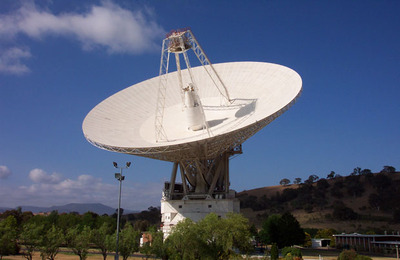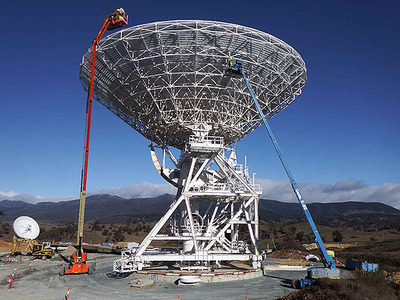Ground control: the ultimate comms centre
Attendees at the Comms Connect conference in Melbourne in November will be treated to a special keynote address that promises to be quite ‘out of this world’.
Radio engineers accustomed to developing terrestrial fixed or mobile radio networks often think they have it tough when trying to design systems to transmit and receive weak signals across spans of tens of kilometres. But spare a thought for those whose job it is to communicate across interplanetary distances.
Len Ricardo is operations manager at NASA’s Deep Space Network tracking station at Tidbinbilla, near Canberra. Formally known as the Canberra Deep Space Communication Complex, but colloquially as simply ‘Tid’, the facility is staffed by Australians and managed by the CSIRO. It’s one of only three NASA deep space tracking stations, the others being in California and Spain.
Ricardo’s communications career has taken him from dealing with cow cockies in the remote interior of the Australian continent to controlling robotic spacecraft on the remote outskirts of the Solar System. His presentation at Comms Connect, ‘Capturing whispers from deep space’, will highlight the unique challenges posed by communicating across millions of kilometres of empty space.

How did you get into communications?
I spent five years in the television and radio service industry in Mt Isa in the 1970s. But the company I was working for didn’t have any great vision about improving themselves; there were golden opportunities they were missing. The Royal Flying Doctor Service was going through a major transition in its communications, because ACMA’s predecessor at the time deemed that AM radio was on the way out and single sideband was the way to go.
Some of the stuff the cow cockies had was truly ancient. Some of it was the original Traegar stuff. But the company wouldn’t buy equipment to have in stock to sell to them. You’ve got to understand the psyche of a cow cockie - he likes to come into town once every three months or so. And if the gear he needs is not there, he’ll go somewhere else.
We were the only company selling radio equipment, and we were prepared to sell anything, any brand. There was a Codan one and there was a Traegar. We would sell either, but we wouldn’t keep them in stock. In desperation, I bought a radio and an antenna to at least demonstrate them to the customers. But the company still wasn’t prepared to lash out and have the stuff in stock.
So I looked for other work. I applied for jobs at Coonabarabran and here at Tidbinbilla. I was offered the Tidbinbilla job and started in 1978.
CSIRO manages Tidbinbilla now. Which organisation was running it back then?
The Department of Supply was the entity to interface with the US government. The company that I actually worked for when I came down here was Fairey Australasia. They got taken over eventually by AWA. Then British Aerospace came in, and then they turned into British Aerospace Australia and later BAE Systems, followed by Raytheon Australia. Finally, CSIRO, as the then government agency decided they would take over the whole thing themselves, rather than letting it out to a contractor.
What does an operations manager at a NASA tracking station do?
I oversee the operation of the antennas. I’ve got four shift supervisors who look after the day-to-day activities. I keep an overview of that and look at the things that are coming in the future and try to prepare the site and everybody for those types of activities. I look at the blue-sky stuff of what is to come, and there are some amazing things to come.
How many antennas does Tidbinbilla have?
We have several antennas that are active currently. One, the 26 m, is the original Honeysuckle Creek antenna that took the first images of Armstrong as he climbed out onto the Moon. And then there’s the big 70 m antenna and two 34 m antennas.

We’ve got a new 34 m antenna that is just being built. The structure has been completed and now we’re doing some testing on it to make sure the panels are appropriately aligned. We’ve got to get them to within a millimetre of surface RMS. Because we work in the K and X bands, we need to have an extremely accurate surface. Hopefully it will go online this time next year.
A second new 34 m antenna is currently just a hole in the ground. Construction of the pedestal is expected to start in November.
We’re building 34 m antennas because 70 m ones are too expensive to make these days - you’re looking at about $500 million - whereas you can do a 34 m for about $55 million.
How many spacecraft are you tracking at the moment?
A bit over 40. We don’t talk to all of them every day. Some of them work autonomously and they don’t need to be communicated with every day. The most distant one we track is Voyager 1.
What will you be speaking about at the Comms Connect conference?
The various ways in which we communicate from a deep space perspective. It’s easy to communicate with a comsat in geostationary orbit - it’s almost instantaneous. But for the missions we track, it’s not instantaneous. If we want to talk to Voyager 1 for instance - if we want to tell it to do something - we send a command now and the answer will come back in 28 hours.
The signal we’re looking at is extremely weak. When the Voyagers left Earth 36 years ago, they had a 25-watt transmitter on them - about the same as a refrigerator lamp. With the ageing of the travelling wave tubes on the spacecraft, they’re down to about 10-13 watts.
We’ve got an inverse square depletion of the signal. As you double the distance, you halve the signal power. The amount of energy we receive from a spacecraft like Voyager 1 makes it equivalent to listening to a fly walking the ground.

So you must have fabulously low-noise receivers?
That’s right. That’s the challenge we have - the weakness of the signal. We started off with travelling wave maser amplifiers. Masers are challenging. We were running them with liquid helium, at around 4 kelvin. The cooling loop was extremely challenging to keep cold.
Then eventually we went to FETs, warm FETs and cooled ones, not particularly sensitive because they were operating at ambient temperatures. Nonetheless, they did do some amplification. We’ve since come to the cooled HEMT, which is a far better device, very broadband, which is a challenge in itself. You run into the problem of saturation at times with a HEMT because it is so broadband. But we can put a filter in front of the front end of the antenna and get a fairly good signal. And we can get operating temperatures on our HEMTs of somewhere between 20 and 40 kelvin. The 4-kelvin maser used to have an operating temperature of around 15 kelvin, so we’ve lost a little bit. Ten kelvin is about a 1 dB loss of signal. Nonetheless, it is still fairly comfortable for what we want to do and it’s a much simpler system.
Finally, what is your favourite space mission?
One that’s long gone - Pioneer Venus in 1978 - where we supported five spacecraft simultaneously. There was the main spacecraft, the bus, which was Pioneer 13, and on the bus were four smaller spacecraft - one large probe and three small probes. The bus was spun up about 60 days out from Venus encounter and the probes were ejected and continued on their way, relying totally on batteries to keep them alive in a switched off state. When they got to Venus, they switched on as they hit the atmosphere and descended rapidly. Small probe number two reached the surface and continued to transmit for another hour, which means that we got some data from the surface and we also then got a dump again of the data that had been collected on the way down.
It was exciting. We did an enormous amount of testing beforehand, simulating all sorts of unsatisfactory conditions we might end up with. But on the day we had perfect conditions and an outstanding result. It was very memorable. We pulled off a mission that supported five spacecraft simultaneously.

Would a mission like that today be considered almost routine?
Yes. With Mars for instance, we regularly support two or three spacecraft simultaneously.
And that’s with the one dish and the one beam?
Yes, because the beam is narrow enough. It’s a little bit of a challenge when Mars is close - when it and the Earth are on the same side of the Sun. But when Mars is on the other side of the Sun, and is much further away, we can get multiple spacecraft in the one beam easily.
Don’t get me wrong. All the other missions have been memorable, but Pioneer Venus was particularly challenging considering that the equipment we had at the time was fairly old. Nowadays we’ve got much smarter receivers with much better capabilities.
2025–26 Thought Leaders: Tim Karamitos
Tim Karamitos from Ericsson discusses the connectivity requirements of emergency services and...
2025–26 Thought Leaders: Ruth Tovo
Comms Connect panellist Ruth Tovo, from the South Australian SES, discusses the technical...
ARCIA update: celebrating excellence in our industry
The ARCIA Annual Gala Dinner and Excellence Awards took place during the same week as Comms...




